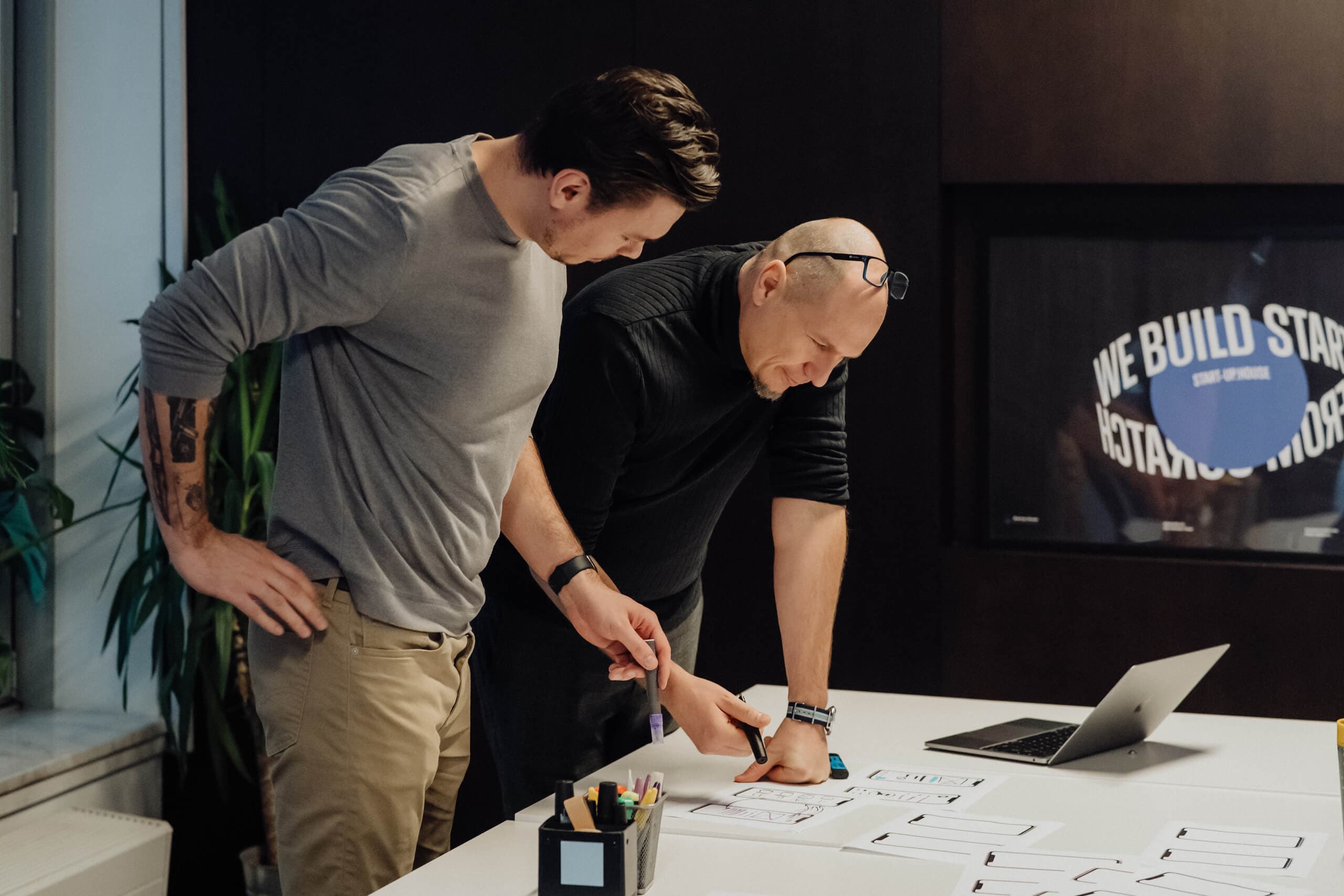Why Should You Build A Product Based On User Testing?
Nigel Tsopo
Sep 30, 2022・6 min read
Table of Content
What is user testing?
User testing vs user research
How do user tests benefit a digital product?
How to conduct user testing step by step
User Testing methods
Beta testing
Surveys
A/B tests
Individual in-depth interviews
Focus groups
Usability testing
Task analysis
Heuristic evaluation
Cognitive walkthrough
Usability testing with eye-tracking
Think-aloud protocol
Why is it crucial to take user research seriously
Conclusion
Summary
Thoughtful teams develop products that are useful and valuable to their target users.
At Startup House, ensuring a seamless user experience is among our top priorities, which is why we firmly believe in building products that are based on user testing.
By using design methods that are based on people's real experiences, we develop high-quality digital products. We recognize that the revenue-generating features of a quality digital product are those that make it most easily accessible and necessary to the people who use it.
Therefore, we believe that conducting user testing improves user retention and results in a more viable product.
So, let's explore in greater depth some of the key concepts behind user testing, and consider why it has become so indispensable to building a commercially successful product.
What is user testing?
User testing assesses the usability of a product or system. It provides insight into how well the product or system works from the perspective of actual users, and thereby helps identify areas in need of improvement.
Although there are many different ways to conduct usability testing, all invariably involve observing users as they interact with the product or system that is being tested.
Testing can be done in person or online using screen-sharing software. User tests typically involve task-based scenarios where users are asked to complete specific tasks whilst using the product or system.
User testing vs user research
The user research process investigates your target audience's needs, wants and behaviours, and is typically done via interview, survey, focus group or user observation. Its goal is an understanding of how your target audience thinks and behaves by which your product may be improved to achieve user satisfaction.
User research and user testing are two different approaches that can be used to gather information about how users interact with a product.
User research is typically more focused on understanding the user's needs and motivations, while user testing is more focused on observing how users actually use the product.
A good user testing company will ensure your products are usable and that they meet the needs of your target market. They can provide valuable feedback on your designs, prototypes and final products.
At Startup House, we have a team of experienced professionals who know how to get the most out of user testing.
We will give actionable feedback from your target audience, and, recognizing that every business is different, also offer a user testing service that can be tailored to your specific needs.
Contact us today to learn more about how Startup House can help you improve your user experience -- we're here to answer any questions you have.
How do user tests benefit a digital product?
1. Revealing what users think of your product
2. Identifying areas where your product could be improved
3. Generating feedback that can help guide future development decisions
4. Helping to build user confidence in your product
5. Ensuring that your product is accessible and usable by a wide range of users.
User testing can be an invaluable tool for any digital product and help improve its overall quality and user experience.
How to conduct user testing step by step
User testing provides user insights into which aspects of the user experience design process are working and which ones are not. Here's a simple outline of user testing step by step:
- Make a feature or prototype
- Choose a testing method
- Find users to test
- Define your testing parameters
- Outline a test duration
- Administer the test
- Observe the results
User Testing methods

Beta testing
A preliminary version of a product tested by a limited group of users before release to the general public.
Surveys
A type of quantitative research in which people answer questions to gather data about anything from customer satisfaction to product usage.
A/B tests
Also known as split testing, A/B testing is a comparison of two versions of a product or service to see which performs better.
Individual in-depth interviews
Conversations with people to gather qualitative data, research user behaviors, hidden needs and crucial pain points about a product in development.
Focus groups
Moderated discussions with a group of people to get opinions and perspectives about a product.
Usability testing
Observing users as they use a product or service to identify issues and areas for improvement.
Task analysis
A technique used to break down complex tasks into smaller, more manageable chunks. This identifies the steps needed to complete a task, as well as any potential roadblocks or areas of confusion a user may suffer during a test.
Heuristic evaluation
A usability inspection method applied by expert reviewers for evaluating the design of an interactive system. The chosen testing experts examine the user interface and judge its compliance with recognized usability principles, commonly referred to as "heuristics".
Cognitive walkthrough
A usability evaluation method by which evaluators observe users as they try to complete tasks using an interface. It is particularly useful for identifying potential usability problems so that they can be addressed before the system is released to users.
Usability testing with eye-tracking
Eye-tracking is a means of testing user behavior by which participants' eye movements are tracked as they use an interface. This type of testing can be used to identify areas of difficulty or confusion, as well as to understand how users are scanning and interacting with different elements on a page.
Think-aloud protocol
A type of user test in which participants are asked to verbalize their thoughts as they use an interface. This type of testing can be used to understand how users are thinking about and interacting with a system.
Why is it crucial to take user research seriously
User research is an essential part of the design process, but it's often overlooked or given less attention than other aspects of design. This can be a mistake, as user research can make the difference between a successful product and one that fails.
When conducting user research, it's important to take a few things into consideration:
Have clear objectives. What do you want to learn from your user research?
Choose the right methods.
Find the right participants. It's important to find participants who are representative of your target audience.
Be prepared to listen. User research is all about listening to what users have to say. Be prepared to take feedback on board and make changes to your product based on what you learn.
Analyze your data carefully.
Conclusion
User testing is a process of testing a product by potential users of the product to evaluate the user experience.
Although many factors contribute to the importance of usability testing, its main function is to identify any usability issues with the product so that they can be rectified before release.
User testing can be conducted in various ways, but it is most commonly done through qualitative interviews or surveys.
At Startup House, our testing services are effective because we provide valuable feedback that helps improve the user experience.
We identify areas of improvement and make recommendations accordingly.
Contact us to learn more about how our user testing services can help ensure that your products and services are user-friendly and meet the needs of your target audience.
Summary
User testing is a process in which users are asked to complete tasks using a product or service, usually to assess its usability.
It can gather feedback about features, design, and overall user experience.
There are many different ways to conduct user testing, but one of the most common is to ask users to complete a series of tasks while being observed by a researcher. This type of user test can be conducted in person or remotely using an online tool.
It can be conducted with different types of users, including those who are familiar with the product or service being tested, as well as those who are new to it.
User testing is an essential part of the product development process and should be conducted regularly to ensure that products and services meet the needs of their users.
Digital Transformation Strategy for Siemens Finance
Cloud-based platform for Siemens Financial Services in Poland


You may also like...

The Power of Prototyping: How Startups Achieve Success on a Budget
Prototyping empowers startups to test ideas, save money, and increase their chances of market success.
Alexander Stasiak
Mar 14, 2025・8 min read

Unleashing Creativity: How Design Thinking Transforms Product Development
Design thinking blends creativity with problem-solving, helping teams build user-centric products that truly resonate.
Alexander Stasiak
Apr 08, 2025・12 min read

How to Choose the Best MVP Development Company for Your Project
Choosing the right MVP development company can make or break your product — here’s how to find the perfect partner for a successful launch.
Alexander Stasiak
May 26, 2025・7 min read




